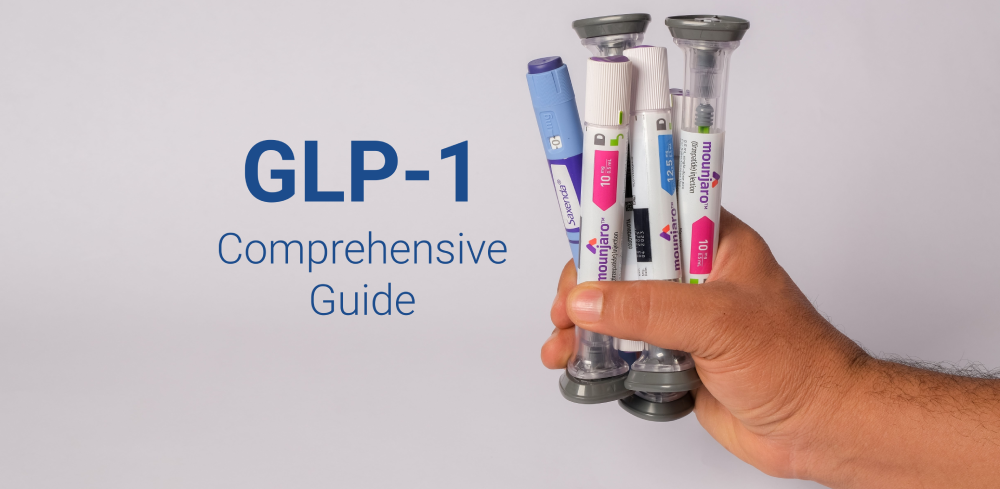
A Comprehensive Overview
Updated May 21, 2024


Eli Luft, PA-C
Dr. Paul Rivas
Key Takeaways
- 1. GLP-1 agonists mimic the GLP-1 hormone, helping regulate insulin, glucose,
and appetite. - 2. They treat type 2 diabetes, aid weight loss, and may improve cardiovascular
health. - 3. Available in injectable and oral forms, dosing varies.
- 4. Common side effects include nausea, diarrhea, and constipation usually
subsiding over time. - 5. Long-term safety is under study; caution is needed for patients with a
history of medullary thyroid cancer.
Introduction to GLP-1 Agonists
Glucagon-like peptide-1 (GLP-1) agonists are a class of medications that have gained significant attention in recent years for their ability to manage blood sugar levels and promote weight loss. These drugs mimic the effects of the naturally occurring GLP-1 hormone, which is produced in the small intestine and plays a crucial role in regulating insulin secretion, glucose homeostasis, and appetite.
Definition and Overview
GLP-1 agonists are synthetic compounds designed to activate the GLP-1 receptors in the body, mimicking the actions of the endogenous GLP-1 hormone. [1] When administered, these medications stimulate insulin release from the pancreas in response to elevated blood glucose levels, thereby lowering blood sugar. Additionally, they inhibit the secretion of glucagon, a hormone that raises blood sugar levels, and slow gastric emptying, leading to a prolonged feeling of fullness and reduced appetite.
History and Development
The first GLP-1 agonist, exenatide (Byetta), was approved by the U.S. Food and Drug Administration (FDA) in 2005 for the treatment of type 2 diabetes. [2] Since then, several other GLP-1 agonists have been developed and approved for clinical use, including liraglutide (Victoza), dulaglutide (Trulicity), semaglutide (Ozempic and Wegovy), and Tirzepatide (Mounjaro and Zepbound). These medications have undergone extensive clinical trials to evaluate their efficacy and safety in managing type 2 diabetes and, more recently, their potential for weight loss.
Mechanism of Action
GLP-1 agonists exert their effects through multiple mechanisms, all of which contribute to their therapeutic benefits. [3] Firstly, they stimulate the release of insulin from the pancreatic beta cells in response to elevated blood glucose levels, thereby lowering blood sugar. Secondly, they suppress the secretion of glucagon, a hormone produced by the alpha cells of the pancreas that raises blood sugar levels. Thirdly, GLP-1 agonists slow gastric emptying, leading to a delayed absorption of nutrients and a prolonged feeling of fullness, which can contribute to reduced food intake and weight loss.
Clinical Applications
Type 2 Diabetes Management
Glucagon-like peptide-1 (GLP-1) agonists have emerged as a crucial class of medications for managing type 2 diabetes, a chronic condition characterized by insulin resistance and impaired glucose regulation. By promoting insulin release and inhibiting glucagon secretion, GLP-1 agonists effectively lower blood sugar levels, providing a valuable therapeutic option for individuals with type 2 diabetes.
While metformin remains the first-line treatment for type 2 diabetes, healthcare providers may recommend GLP-1 agonists in various scenarios. These include situations where metformin is ineffective, contraindicated, or when patients fail to reach their target glycemic control despite treatment with metformin and other medications. [2] Additionally, GLP-1 agonists may be prescribed for individuals with type 2 diabetes who have coexisting conditions such as atherosclerosis, heart failure, or chronic kidney disease, as these medications have demonstrated potential benefits beyond glycemic control.
Weight Loss and Obesity Treatment
In addition to their role in managing type 2 diabetes, GLP-1 agonists have gained significant attention for their potential in promoting weight loss and treating obesity. The appetite-suppressing effects of these medications, coupled with their ability to slow gastric emptying and induce a prolonged feeling of fullness, contribute to reduced food intake and subsequent weight reduction. [3]
The U.S. Food and Drug Administration (FDA) has approved semaglutide (marketed as Wegovy) and Tirzepatide (marketed as Zepbound) specifically for chronic weight management in adults with obesity or overweight individuals with at least one weight-related comorbidity, such as high blood pressure, type 2 diabetes, or high cholesterol. [4] These medications are typically prescribed in conjunction with a reduced-calorie diet and increased physical activity, as part of a comprehensive weight management program such as ours here at Rivas medical Weight Loss
Potential Benefits Beyond Glycemic Control
While GLP-1 agonists are primarily used for blood sugar control and weight management in type 2 diabetes, they also show promise in providing additional health benefits. Research, including recent findings from the SELECT trial, indicates that GLP-1 agonists like semaglutide can significantly reduce the risk of major cardiovascular events, such as heart attacks and strokes, especially in individuals with obesity but without diabetes. [7] These medications have also been linked to improvements in blood pressure and cholesterol levels, enhancing overall metabolic health and potentially reducing the risk of heart failure and kidney disease.
However, it remains under investigation whether these benefits are directly due to the GLP-1 agonists or a result of the weight loss they facilitate. Despite this, the ability of GLP-1 agonists to offer multiple therapeutic effects beyond their primary uses is drawing considerable interest from the medical community.
Types of GLP-1 Agonists
Injectable Formulations
Glucagon-like peptide-1 (GLP-1) agonists are primarily available as injectable formulations, administered subcutaneously (under the skin). These injections are designed to mimic the actions of the naturally occurring GLP-1 hormone, which plays a crucial role in regulating insulin secretion, glucose homeostasis, and appetite. [1]
Injectable GLP-1 agonists are divided into short-acting and long-acting formulations. While short-acting versions like daily injections may better control postprandial glucose levels, they have largely been replaced by long-acting alternatives such as semaglutide (Ozempic and Wegovy) and tirzepatide (Mounjaro and Zepbound), which only require weekly injections. This reduced frequency can enhance patient adherence and convenience, potentially improving treatment outcomes. [5]
Oral Formulations
While most GLP-1 agonists are injectable, semaglutide (Rybelsus) is available as a once-daily oral tablet. It offers an alternative for those averse to injections but has different absorption rates and pharmacokinetic properties that may affect its efficacy and side effect profile. Notably, the oral version is only approved for diabetes, not weight loss, and may cause more gastrointestinal side effects. Using it off-label for weight loss would require much higher doses than it is currently approved for and it would not be cost effective. [3]
Comparison of Available Options
With multiple GLP-1 agonists available, healthcare providers and patients have the flexibility to choose the formulation that best suits their individual needs and preferences. Factors such as dosing frequency, route of administration (injectable or oral), and potential side effects may influence the selection process.
For example, individuals who prioritize convenience and adherence may prefer long-acting injectable formulations.
Additionally, the specific indications and approved uses of each GLP-1 agonist should be considered. While most are approved for the management of type 2 diabetes, some formulations, such as semaglutide (Wegovy) and tirzepatide (Zepbound), have also been approved for chronic weight management in adults with obesity or overweight. [4]
Ultimately, the choice of GLP-1 agonist should be a collaborative decision between the patient and their healthcare provider, taking into account individual factors, treatment goals, and potential risks and benefits.
Dosing and Administration
Recommended Dosages
GLP-1 agonists come in various dosage forms and strengths, with specific recommendations for each medication. According to the U.S. Food and Drug Administration (FDA), the approved dosages for some of the commonly prescribed GLP-1 agonists are as follows:
- Semaglutide (Ozempic): 0.5 mg, 1 mg, or 2 mg once weekly for type 2 diabetes, and up to 2.4 mg once weekly for chronic weight management (marketed as Wegovy). [6]
- Tirzepatide (Mounjaro): up to 15 mg once weekly for type 2 diabetes, and up to 15 mg once weekly for chronic weight management (marketed as Tirzepatide). [6]
- Liraglutide (Victoza): 1.8 mg once daily for type 2 diabetes, and 3 mg once daily for chronic weight management (marketed as Saxenda). [1]
- Dulaglutide (Trulicity): 0.75 mg or 1.5 mg once weekly for type 2 diabetes.
- Exenatide (Byetta): 5 mcg or 10 mcg twice daily for type 2 diabetes.
- Exenatide extended-release (Bydureon BCise): 2 mg once weekly for type 2 diabetes.
It’s important to note that these dosages may vary based on individual patient factors, such as weight, age, and overall health status. Our Healthcare providers at Rivas Medical Weight Loss carefully consider these factors when prescribing GLP-1 agonists to ensure optimal efficacy and minimize potential side effects.
Titration Schedules
Many GLP-1 agonists require a gradual dose escalation, known as titration, to help minimize gastrointestinal side effects like nausea and vomiting. This process involves starting with a lower dose and gradually increasing it over several weeks or months until the target therapeutic dose is reached.
For example, with semaglutide (Ozempic), the recommended titration schedule for type 2 diabetes involves starting with a 0.25 mg dose once weekly for four weeks, followed by an increase to 0.5 mg once weekly for at least four weeks. If additional glycemic control is needed, the dose can be further increased to 1 mg and 2 mg once weekly. [1] Similar titration schedules are recommended for other GLP-1 agonists to help improve tolerability and adherence.
Administration Routes and Techniques
Most GLP-1 agonists are administered via subcutaneous injection, meaning the medication is injected into the fatty tissue just under the skin. The injection sites commonly used include the abdomen, thighs, or upper arms. Proper injection technique is crucial to ensure the medication is administered correctly and to minimize potential injection site reactions.
At Rivas Medical Weight Loss or Healthcare providers typically provide detailed instructions on how to prepare and administer the injections. Patients may also receive training on injection techniques to ensure they can self-administer the medication safely and effectively.
One exception to the injectable formulations is semaglutide (Rybelsus), which is available as an oral tablet. This medication is taken once daily on an empty stomach, at least 30 minutes before the first food, beverage, or other oral medication of the day. [3] The availability of an oral formulation offers an alternative for patients who prefer or require an oral medication over injections.
It’s essential for patients to follow the specific dosing and administration instructions provided by their healthcare provider to ensure the safe and effective use of GLP-1 agonists.
Safety and Side Effects
Common Side Effects
While GLP-1 agonists offer significant benefits for managing type 2 diabetes and promoting weight loss, they are not without potential side effects. According to the U.S. Food and Drug Administration (FDA), the most commonly reported side effects of these medications include nausea, diarrhea, vomiting, constipation, abdominal pain, headache, fatigue, indigestion, dizziness, bloating, belching, and flatulence. [4] These gastrointestinal symptoms are often mild to moderate in severity and tend to diminish over time as the body adjusts to the medication. Our clinical experience has taught us that most patients tolerate the medications well the proper dosing protocols in place and proper management of adverse effects.
For individuals with type 2 diabetes, low blood sugar levels (hypoglycemia) can be a concern when GLP-1 agonists are used in combination with other glucose-lowering medications, such as sulfonylureas or insulin. [1] Healthcare providers may need to adjust the dosages of these concomitant medications to mitigate the risk of hypoglycemia.
Precautions and Contraindications
While generally well-tolerated, GLP-1 agonists are not recommended for certain patient populations or medical conditions. The prescribing information for these medications contains a boxed warning regarding the potential risk of thyroid C-cell tumors, a rare form of thyroid cancer. [4] As a result, GLP-1 agonists are contraindicated in individuals with a personal or family history of medullary thyroid carcinoma or those with multiple endocrine neoplasia syndrome type 2 (MEN 2), a genetic disorder that increases the risk of certain types of tumors.
Other contraindications and precautions for GLP-1 agonists include a history of severe allergic reactions to the medication or its components, acute or chronic pancreatitis, gallbladder disease or gallstones, and certain forms of diabetic retinopathy. [3] Healthcare providers may also exercise caution when prescribing these medications to individuals with kidney disease or a history of suicidal ideation or behavior.
Long-Term Safety Considerations
As a relatively new class of medications, the long-term safety profile of GLP-1 agonists is still under evaluation. Clinical trials have shown their efficacy and safety over several years, yet the possibility of long-term adverse effects remains a research focus. One significant finding is from the SELECT trial, which showed that long-term use of semaglutide in individuals with obesity but without diabetes led to a 20% reduction in major cardiovascular events and an average weight loss of 9.4%. [7] However, the use of GLP-1 agonists during pregnancy and lactation is less well understood, as these groups are typically excluded from clinical trials. Regular follow-up appointments and adherence to monitoring protocols are essential to ensure the safe and effective use of these medications. For those considering medically supervised weight loss, Rivas Medical Weight Loss offers comprehensive plans and expert care to support your health journey.
Conclusion
GLP-1 agonists are pivotal in managing type 2 diabetes and supporting weight loss by mimicking natural hormonal actions that regulate insulin, glucose, and appetite. The availability of both injectable and oral formulations allows for tailored treatment approaches based on individual needs. Ongoing research continues to refine our understanding of these medications. To maximize the benefits and ensure safety, close collaboration with healthcare providers is crucial.
If you’re exploring weight loss options, the structured support and accountability provided by healthcare professionals at Rivas Medical Weight Loss can enhance your treatment success. We invite you to schedule a consultation today and take a step towards a healthier, more fulfilling life.

Lose Weight. Feel Great.
Rivas Medical Weight Loss is here to guide you
with expert care and top quality medication.
Book Appointment
Bibliography
- GLP-1 agonists: Diabetes drugs and weight loss. Retrieved from https://www.mayoclinic.org/diseases-conditions/type-2-diabetes/expert-answers/byetta/faq-20057955
- GLP-1 Agonists. Retrieved from https://my.clevelandclinic.org/health/treatments/13901-glp-1-agonists
- What are the GLP-1 drugs?. Retrieved from https://www.everlywell.com/blog/weight-management/what-is-glp-1/
- FDA Approves New Drug Treatment for Chronic Weight Management, First Since 2014. Retrieved from https://www.fda.gov/news-events/press-announcements/fda-approves-new-drug-treatment-chronic-weight-management-first-2014
- GLP-1 Receptor Agonists. Retrieved from https://diatribe.org/glp-1-agonists
- Medications containing semaglutide marketed for type 2 diabetes or weight loss. Retrieved from https://www.fda.gov/drugs/postmarket-drug-safety-information-patients-and-providers/medications-containing-semaglutide-marketed-type-2-diabetes-or-weight-loss
- Semaglutide and Cardiovascular Outcomes in Obesity without Diabetes. Retrieved from https://www.nejm.org/doi/full/10.1056/NEJMoa2307563





